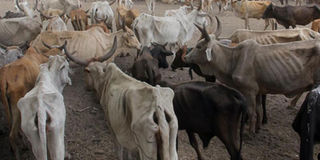Igad nations ink deal to improve livestock disease surveillance

Thousands of cows brought to the Kenya Meat Commission in Kibarani, Mombasa, on February 8, 2017 for purchase. Livestock contributes 40 per cent to the Somalia’s GDP. PHOTO | LABAN WALLOGA | NATION MEDIA GROUP
What you need to know:
- On Friday, Igad signed an agreement with the Food and Agriculture Organisation to help improve on livestock management systems.
- FAO said the scheme would target communities living near the Ethiopia, Kenya and Somalia borders.
Three member countries of the Intergovernmental Authority on Development (Igad) are set to benefit from a new programme meant to control movement of livestock across the borders and tackle rustling.
On Friday, Igad signed an agreement with the Food and Agriculture Organisation (FAO) to help improve on livestock management systems.
The deal means that Kenya, Ethiopia and Somalia would improve disease surveillance, data collection on animal numbers and productivity, access to markets and enable them trace stolen animals.
FAO said the scheme would target communities living near the Ethiopia, Kenya and Somalia borders.
It would also involve educating communities on proper and economical animal farming, bearing in mind that the area is prone to drought.
The Sh1 billion five-year project, to be funded by the Swiss Agency for Development and Corporation, would be managed and implemented by FAO and Igad.
But it would only begin when the three countries set up policies to tap into the programme.
FAO’s coordinator for Eastern Africa Patrick Kormawa said past experience had necessitated the development of the programme.
“This programme embraces the principle of investing nationally while thinking regionally to ensure coherent and harmonised action across countries,” he said during a conference on drought resilience organised by Igad in Nairobi.
ANIMAL TRACKING
The decision to launch the programme comes when the regional organisation was spearheading efforts to regulate the movement of livestock between member countries.
Last year, Igad Executive Secretary Mahboub Maalim said the authority will be looking for a regional livestock tracking system it hoped would end cattle rustling and improve beef trade.
Devolution Cabinet Secretary Mwangi Kiunjuri said that countries in the region needed to implement policies that would enhance cooperation in areas of livestock management because the entire area suffers from similar climate conditions.
“Let us be open about our respective experiences so that our collective understanding of how to strengthen resilience to drought, as well as quality of our interventions on the ground are both enhanced,” he said during the meeting.
“We can go further and explore areas where policy harmonisation would be beneficial for drought affected communities. These policy processes tend to be lengthy and complex so let us move quickly to identify any areas where such work would be beneficial,” he said during the meeting.
As for now, each country has been using their own methods of tracing and identifying their livestock, making it difficult to control the flow of animals from one side to another.
Still, none of the countries has fully established their tracking system.
In Kenya for instance, there is no conclusive figure of livestock kept, especially by nomadic keepers in the north.
REVENUE
The last comprehensive census was conducted in 1969 and the government usually estimates that livestock keeping comprises about 12 per cent of the GDP. Its true potential to the economy is still unclear.
“How can the country or the counties plan effective measures to mitigate the drought risks?” posed Mandera Governor Ali Roba, who chairs a committee of 24 arid counties in the country.
“The entry point should always be from a known position in-terms of having a fairly reflective livestock numbers to determine the level risk reduction inputs required in a given region.”
While Kenya has experimented with electronic radio frequency identification chips, Ethiopia with the largest cattle population at 52 million, in Igad region has tags.
Somalia also doesn’t have an identification system but according to FAO, the country exported 4.9 million goats and sheep, 295,000 cattle and 72,000 camels, earning about $384 million (Sh38.4 billion).
Livestock contributes 40 per cent to the Somalia’s GDP.





